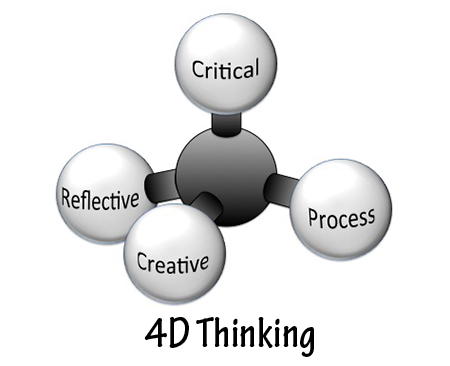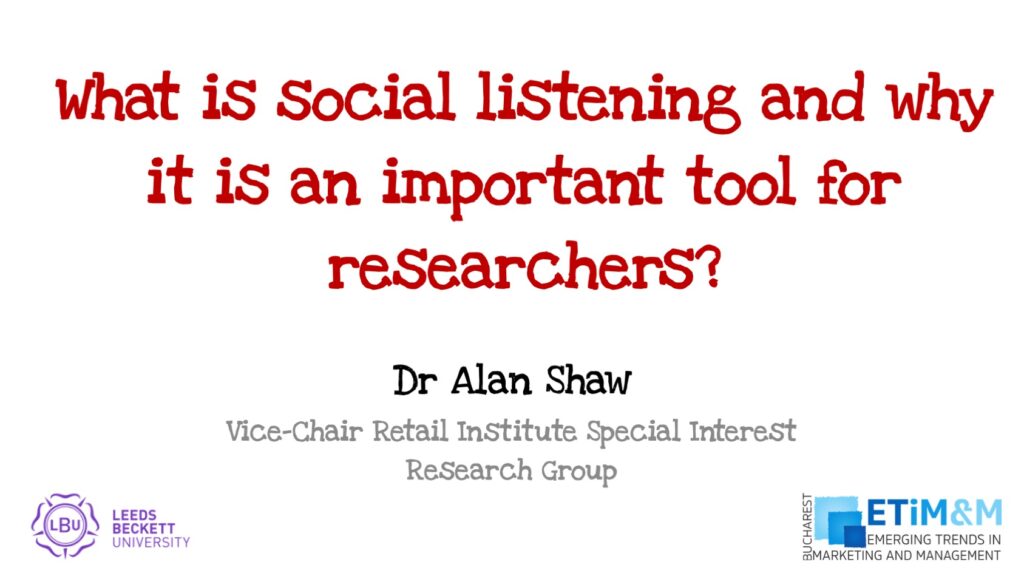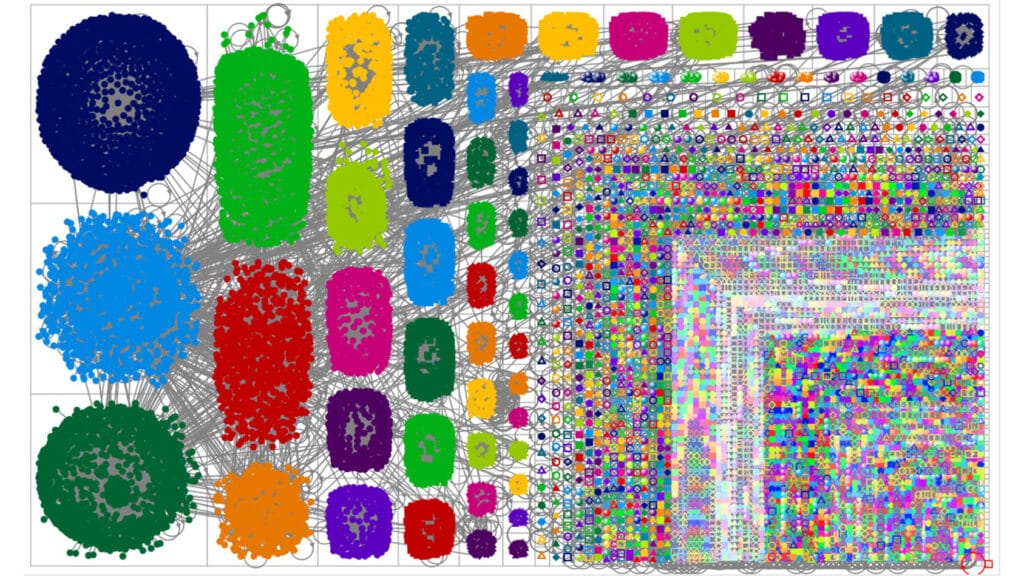In my view thinking is an activity that attempts to visualise (in your mind’s eye) a problem, solution, memory, idea, image, sound or … add whatever you believe to more appropriate: the list is almost endless. It can be factual, fictional, mischievous or reverend. We all do it hundreds of times a day: as part of our work, our studies, our home lives or just to escape from the reality of what’s going on around us.
There are many types of thinking, they include (but are not limited to):
- Reflective thinking
- Critical thinking
- Creative thinking
- Divergent thinking
- Convergent thinking
- Lateral or Parallel thinking
- Logical thinking
- Structured thinking
- Positive thinking
- Process thinking
Rather than look at these individually, I would like to focus on the type of thinking that should be done when designing a solution to a problem. This I have called 4D (4 Dimensional) Thinking. It is made up of:
- Reflective Thinking.
- Critical Thinking.
- Creative Thinking.
- Process Thinking.
The concept is an adaptation of the work of Mark Hill (2012). Unlike Hill, I have used “Process Thinking” as forth dimension and not “Time”. The process element is critical if you want to ensure that the implementation is a success. I have seen many organisations come up with great creative solutions to problems but fail because their implementation plans were unworkable or cumbersome. Time is still an important factor but its consideration should be part of the Project Management Triangle (or the Iron Triangle): see figure 1. This is where the project team have to decide how to balance Quality, Time and Costs constraints: the limiting factors which are common in all projects.
4D Thinking starts by considering “what is happing now” and “what has happened in the past”. This is the Reflective part, but we must also utilise Critical and Process Thinking. I suggest you use tools like the PESTLE Analysis, Porter’s Five Forces, SWOT Analysis and Process Mapping to review the situation. It should be iterative with you constantly asking yourself “what does this mean”? By doing this you can quickly exclude factors that are irrelevant or drill down on those that are more important. The Mapping Process should give you a pictorial view of the current ways of working (if you are embarking on a totally new project you should compare it with either a competitor’s process or one which is similar to what you hope to introduce).
The next part of the 4D Thinking is the development of the new plan (the plan could be for a new product, service, event, ways of working, etc). Here we start with Creative Thinking: this is done in three phases, the first phase is where anything goes: you list all possible ideas. The second phase is where you short list your ideas and select the best one: we now need to re-introduce Critical Thinking. You must ensure that all factors have been considered and appropriate contingencies are in place to maximise the likelihood of success. The final phase is the turning of the plan into a reality. Here we re-introduce the Process Thinking again: you should map out exactly what should happen at each stage in order to make the plan a success. Critically review each element to ensure that they are needed and are workable.
The whole concept is not new, it merely adopts a systematic approach to tackling problems. It is one that I have found very useful in my career and lead to great successes.
Foot Note: A quick summary of the types of thinking used in 4D Thinking.
Reflective thinking.
Reflective thinking is a method of thinking that builds on your experience. You would consider what has happened and learn from the mistakes and successes that you and others have made. From a strategic planning point of view, the analysis of the macro and micro environments together with SWOT reviews introduces the concepts of Critical Thinking.
Critical Thinking.
Critical think is a process that is not done in isolation but is part every element of the 4 Dimensional Thinking. “Critical Thinking involves evaluating the thinking process – the reasoning that went into the conclusion we arrived at or the kinds of factors considered in making the decision” (Halpern, 2002 p7).
You would generally use critical thinking in making your decision or coming to a conclusion. A way of enhancing the Critical Thinking process is by introducing the element of creativity.
Creative Thinking.
Creative thinking is a process that allows you to come up with new ideas. Most of you will think it is best done in groups using Brainstorming or Lateral Thinking processes, although studies have concluded that group participation inhibits creative thinking (Tailor, Berry & Block, 1958; Dunnette, Campbell & Jaastad, 1963 and Goncalo & Staw, 2006). Paulus (2000) on the other hand suggests that interaction in groups and teams can be an important source of creative ideas and innovations. The other thing you need to consider is how to gain buy in from the team if they are not involved. Later I will describe how it is best to run a brain storming session.
Process Thinking.
Process thinking is a mechanism that ensures that your creative solution can be implemented in an efficient and effective manner. The objective is to ensure that the workflow is achievable. My favourite way of using Process Thinking is to utilise the IDEF0 modelling eechnique. IDEF0 stands for Icam DEFinition for Function Modeling. The US Air Force commissioned it from the developers of the Structured Analysis and Design Technique (SADT) graphical language.
References:
Hill, M. E. (2012). Marketing Strategy: The Thinking Involved. SAGE Publications, Incorporated.
Alan Shaw
Latest posts by Alan Shaw (see all)
- What is social listening and why it is an important tool for researchers? - July 31, 2021
- COVID-19 and Remote Learning: Experiences of parents supporting children with SEND during the pandemic. - June 30, 2021
- Using Netnography To Evaluate The Launch And Collapse Of The European Super League - April 21, 2021
- Developing Semi-Structured Interview Questions: An Inductive Approach. - April 9, 2020
- Developing Semi-Structured Interview Questions: A Deductive Approach - April 9, 2020
















